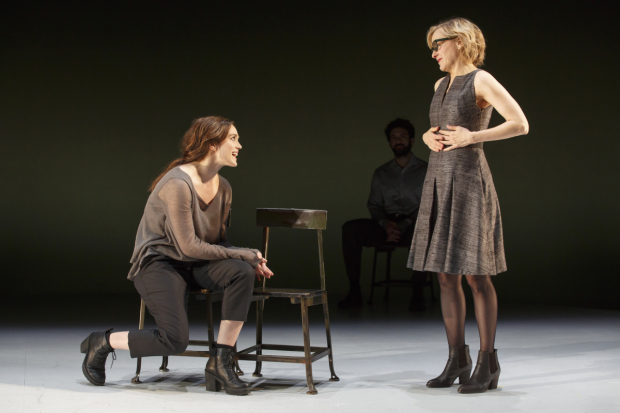Incognito

(© Joan Marcus)
To frequent theatergoers, it should come as no surprise that the British dramatist Nick Payne is one of the most intelligent young playwrights currently working. As evidenced in his past New York productions, If There Is I Haven't Found It Yet and Constellations, Payne's chief skill is in taking particularly academic subjects, like global warming in the former and quantum physics in the latter, and presenting them in such away that is both digestible for all audiences and wrenchingly dramatic.
His latest, Incognito at Manhattan Theatre Club's New York City Center – Stage I, is no different, and even further confirms that Payne is in a class of his own as a contemporary writer. Intertwining several different narratives and spanning five decades, Incognito is an examination of the brain through the lens of personal identity.
Two of the major intersecting storylines are based loosely on fact. The first follows Thomas Stoltz Harvey (Morgan Spector), the pathologist who conducted Albert Einstein's autopsy in 1955 and famously stole his brain in the name of scientific research. The second, in the same era, is inspired by the life of Henry Molaison (Charlie Cox), or, Patient H.M., a man who spends the bulk of his adult life suffering from anterograde amnesia (the inability to create new memories) after surgery to cure epileptic seizures. The third, in the present day, follows Martha (Geneva Carr), a divorced neuropsychologist embarking on her first relationship with another woman, Patricia (Heather Lind).
Over the course of the play, Payne calls for each actor to play several other characters throughout the different stories. For instance, Cox not only plays Henry, but he also plays Martha's grown son Ben and Albert Einstein's son Hans. Lind is Patricia, but also appears as Henry's devoted wife Margaret and a character named Lisa-Scott, a sexy young waitress who attracts Thomas.

(© Joan Marcus)
Through this exacting conceit of dramatic writing, Payne's so-called major dramatic questionx arises: Is there really such a thing as the "self"? Or is it the construct of the brain, an organ that, as Martha puts it, is "exhaustively working overtime to develop the illusion that we are in control," but that is really nothing more than a mere "storytelling machine"?
Discussions like these could alienate an audience right from the start. Payne's writing style, however, allows for such heady concepts to spring naturally from everyday conversations. In fact, Incognito never once feels like a stolid post-grad lecture on neuroscience. Through and through, it is a compelling, humane story, featuring absorbing characters with whom we feel a kinship.
It helps that director Doug Hughes has employed a quartet of instantly likable performers who dexterously shift from role to role, dialect to dialect, with an exceptional nimbleness. Carr, Cox, Lind, and Spector are the truest definition of a theatrical ensemble, bringing passion to every moment (even when a scene is only a few lines long), and volleying back and forth with laser-like precision. Were any to be singled out, though, it would have to be Cox, whose supremely moving and thoroughly heartbreaking work as Henry gives the play its emotional center.
While there are points where Hughes' staging tends to lag, his work impresses here for its decision to let the audience conjure the world of the play ourselves. Scott Pask's bare-bones set consists simply of a floor, a wall, and four chairs, while Catherine Zuber's costumes for each actor consist of either button-down shirts and slacks or a dress, varying in shades of black or gray. David Van Tieghem's underscoring expertly sets the brain's thought processes to music, while Ben Stanton's lighting delineates changes in scene.
In effect, we are called upon to use our own brains (and imaginations) to create the bustling hipster café where Martha and Patricia first meet, the diner where Thomas and Lisa-Scott first fall in love, and the nursing home where Henry runs out his life struggling to play the piano. It is a very fitting choice for this excitingly theatrical look at the human mind, the most mysterious subject matter of all.










